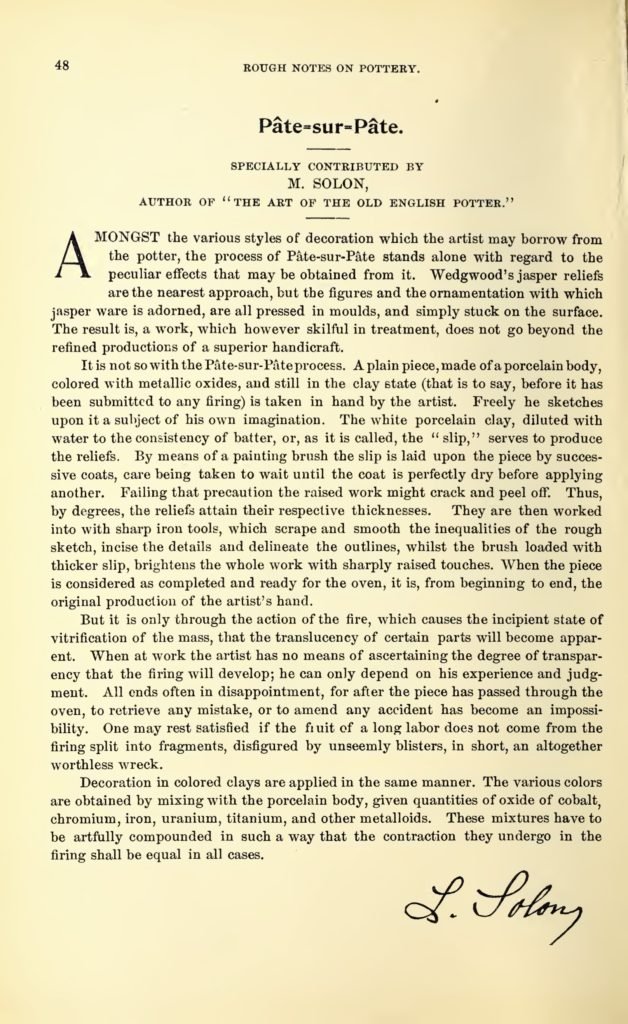Pâte-sur-pâte
Late-Ming Dynasty
Two centuries before the development of pâte-sur-pâte ("paste on paste") at Sèvres, late-Ming Dynasty Chinese potters were experimenting with a bold decoration technique using brushed slip. This type of Zhangzhou (or "Swatow") ware employed white slip brushed in lively patterns on cobalt blue, iron brown, or even white backgrounds. The slip was vitreous and partially melted into the glaze, giving thinner strokes translucency against the darker ground, while thicker areas of slip remained white and opaque.
Various techniques of slip decoration had been employed for centuries before, not only China but other places, for example Persian Kerman Period fritware. But this type of Zhangzhou slip decoration is the first I'm aware of that realized the possibility of layering slip to create not only translucency but also three-dimensional surface texture.
Qing Dynasty
Late-Ming Dynasty potters had invented a novel way of decorating ceramics with brushed slip, but it wasn’t until the Qing Dynasty that the possibilities of the technique became fully realized in the masterful hands of that era’s potters. Slip was brushed over, under, and even in-between glazes. Or, in the case of Yixing ware, the slip was painted directly onto the bisque body without any glaze at all. Traditional decorative techniques and motifs became even more expressive now that three-dimensional layers and translucency could be employed.
I’d love to see a Nigel Wood-style comparison of chemical analyses of these slips, and how they contrasted with the analyses of the materials, clay bodies, and glazes of the time. Contemporary ceramicists often explore the glaze-clay continuum, and it appears to me that those Qing Dynasty potters were playing with the same ideas with their vitreous slips.
19th Century European
For me, one of the most exciting aspects of ceramics is tracing how techniques are transformed and adapted to new eras and cultures. Two centuries after Ming Dynasty potters began experimenting with brushed slip techniques, the French "invented" pâte-sur-pâte.
The Wikipedia entry for pâte-sur-pâte mentions its Chinese origins only once: "[Manufacture nationale de Sèvres] was trying to reproduce a decorative technique from a Chinese vase, but misinterpreting the vase, the experiment took them along a different path from the Chinese potter."
Historical documents often only mention pâte-sur-pâte's Chinese origins in passing or not at all, including Solon's article in Jervis' "Rough Notes on Pottery" (1896). Hobson's "Memorial Lecture on Mr. M. L. E. Solon" (1915) is one rare moment of candour: "Though pâte-sur-pâte was described as a novelty at Sèvres, it can only be regarded as a new application of an old principle." And later, "For four centuries or more the Chinese have applied the true pâte-sur-pâte methods to decoration of porcelain…"
I don't believe French pâte-sur-pâte was a technologically "different" path. As with other Chinese ceramic techniques, including porcelain itself, Europeans copied the technology and then adapted it to their own culture. To my eyes, European pâte-sur-pâte was less technically advanced than the myriad of brushed slip techniques employed by Qing potters. But once they figured out the basics, the Europeans applied it with gusto: "But the French, once they had mastered the principle of this Chinese decoration, began to apply it on a much more ambitious scale." (Hobson, p. 84) Unfortunately, the time required to hand-decorate each piece with so much pâte-sur-pâte meant that its cost was prohibitively expensive, and it could not compete with cheaper methods of decoration like sprigging.
Illustration from "Pâte-sur-pâte", M.L. Solon, The Studio, Volume Two, 1894, pp. 117-122









